
In 1941-1945 German invaders committed 57 mass executions in 40 places in Łomża region. There were executed more than 30 thousand civilians. In 4 nearby forests there were committed 9 documented executions and at least several more probable. Three executions (in summer 1942 and July 1943) took place in the forest in the proximity of Jeziorko village.
Book "Jeziorko – the Place of National Remembrance“ is the written result of 60 year-long-effort to reveal the truth about Nazi invaders war crimes at the glade of Jeziorko forest. There is information included which could be confirmed in credible sources.
This publication is the guide through renovated in 2007 cemetery and it discusses not an easy over 50 year-long-history. It shows also that the Place of National Remembrance could be not only a place where periodic celebrations take place but also a place where memory of the faithful to the motto of God, Honor, Homeland and those who sacrificed themselves, could be conveyed.

Back to the Polish website
TABLE OF CONTENTS
HISTORICAL CATCHWORDS
JEZIORKO – THE PLACE OF NATIONAL REMEMBRANCE
SITE MAP
THE ELDERLY
PRISONERS
HOSTAGES OF ŁOMŻA
THE CEMETERY
VISITING CEMETERY
WIKIPEDIA

New Acts Archive in Warsaw. The central national archive that gathers documents of the years after 1918 and after 1990 also documents from the former KC PZPR.
KC PZPR. The Polish United Worker's Party Central Committee - Management of created in 1948 political party based on a communism doctrine and tradition of communism movement. PZPR throughout the period of existence (self-dissolution took place on 29th January 1990) was a mass party that led the country in an authoritarian way as well as led centrally managed and over bureaucratic economy.
Commander officer of Security Police and SD (German). He led the criminal police as well as Security Service (special organizations).
East Prussia. A province in the 3rd Reich up to 1945. In 1945 divided between Soviet Russia and Poland. Nowadays it is Warmia and Mazury in Poland - a region of North-East Poland.
Main Commission for the Investigation of Nazi Crimes in Poland (from 1945-1991). In 1991 renamed to acting up to 1999 Main Commission for Investigation of Crimes against Polish Nation. It led investigations as well as a completed documentation and explorations concerning Nazi and Stalin crimes in Poland.
Institute of National Remembrance - created in 2000, gathers documents of security organizations from the Polish People's Republic, leads investigations in Nazi and communism crimes as well as organizes educational actions.
Main Commission for the Prosecution of Crimes against the Polish Nation - a part of the Institute of National Remembrance that leads investigations in Nazi and communism crimes (continue actions performed by Main Commission for investigation of Crimes against Polish and Main Commission for investigation of Nazi Crimes in Poland)
Council for the Protection of Combat and Martyrdom - an advisory body of Council of Ministers created in 1947 (from 1988 acting as The Council for the Protection of Combat and Martyrdom monuments), commemorates combat and martyrdom places. Along its many responsibilities it looks for places recognized as the Places of National Remembrance, reconstruction and renovating war victims graves, cares for Polish military cemeteries in Poland and abroad as well as sites of mass murders civil citizens.
Government Delegation for Poland - Polish Government in Exile acting during World War II in London. It was recognized by all the members of anti-Nazi coalition. In Poland in the under occupation period there was working its agency called Delegation ran by Government Delegate for Poland who was vice Prime Minister of Polish Government in Exile. This underground administration had all the required equivalent of an official country (regions and districts) called Delegations.
Home Army (AK). A Polish underground military organization, formed on 27th September 1939 as a part of the Military Force of the Republic of Poland, subordinated to commander-in-Chief and the Government in Exile. AK led throughout the whole time of occupation a successful fight against the invader. Germans reacted with terror actions against Polish civilians; one of them was the execution in the proximity of Jeziorko forest, performed on 15th July 1943.

On September 1st, 1939 the German Wehrmacht attacked Poland. 17 days later, on the basis of the secret protocol to the Ribbentrop-Molotov treaty, the Soviet Army crossed the eastern border of Poland. The western part of Poland was occupied by Germans, the eastern part, including the town of Łomża - by the Soviet Union. But the Polish Government was reconstituted in London. In occupied Poland the resistance movement - the underground Land Army - emerged.
After German-Russian war outbreak, in June 1941 Łomża region was occupied by German troops after being taken over from Russians. On 15 July 1941 Adolf Hitler signed a decree and created "Bezirk Bialystok“ that comprised seven Kreiskommissariats (districts).
Bialystok territory that included Łomża region was a special district (Sonderbezirk). Famed Gauleiter and East Prussia President Erich Koch became a civil board president. For war crimes in Łomża region, among others, he was punished with death sentence in 1959, but not executed and died in Polish prison 1986. Bezirk Bialystok was under his power and Polish citizens were treated as slaves, no better than Jews and Gypsies. All schools were closed and obligatory work was introduced for the youth and adult. Food was rationed and rations were very small. All industrial plants, companies and even stores were taken over by Germans. Small misdemeanors like white bread baking, too extensive use of electric energy or delay in farm produce quotas delivery were punished with death. Those were often performed by German authorities. In the end of June 1941 the first group of convicted were executed at Łomża cemetery. At the turn of June and July executions of Łomża region dwellers in the nearby woods started. A number of victims rose every day under any pretext. Apart from Gestapo, military police performed many executions from several up to a few hundred citizens, some of them secretly. Executions were planned to terrorize civilians and to deter them from collaborations with Polish resistance groups as well as were a part of the extermination plan of Jews, Gypsies and Polish citizens.
Łomża was not an exception. Mass civilians executions under any pretext were performed on the territory of Poland throughout all the years under occupation. Mass murder that took place in Poland in those years were often performed on the ground of one German or agent killed by unknown murderers but it was only a propaganda fact. The real aim of executions was to destroy as much of Polish society as it was possible especially of the intelligence, political and economic activists and youths. The reason was to render a quick recovery of Poland after a potential German defeat.
According to literature on the current Łomża region during the whole German occupation there were a few hundred acts of murders at 74 sites. No fewer than 13.027 people were killed in mass murders i.e. no fewer than 10 persons in one act. Today only 292 persons are verified, it means that it is proved where and when they died. The others are nameless victims.
Polish underground authorities (The Government Delegation for Poland) tried to register invader war crimes. They gathered all information about the victims and collective lists were transferred to London. Thanks to that, apart from witness testimonies and collected after war court documents, we have today lists of credible execution victims, especially those murdered secretly. Three mass executions took place at the glade in the forest close to the village named Jeziorko.
Those executions and contemporary cemetery at that site is described in the book.

In the interwar period Łomża region local authorities organized in Pieńki Borowe an old people's home. In 1941 when Germans invaded Poland a few dozen persons between 60-70 years of age lived there and few persons of staff. Invaders did not provided any means of living so the staff had to organize food and fuel.
In Spring 1942 old people asked German authorities to help in improving living standards so they were not surprised when the military police appeared at the site in June at 4 - 5 am. They informed that old people were being taken to a new site where they were to live with other old persons of Bialostocki region. All of them got on the trucks and were taken to the forest close to the village of Jeziorko. There, at the pits in the ground dug by retreating Soviet soldiers they were murdered with handguns. That was the way in which the old people's home in Pieńki Borowe was liquidated.
No documents of the old people's home remained. Therefore it was impossible to state the exact number of massacre's victims. After the war, on the basis of eyewitness' reports, it was assumed, that the number of victims from Pieńki Borowe exceeds at least 60. It achieved to fix 13 victim names only.
1. Aniołkowska
2. Bączkowski
3. Jankiewicz – about 70 years old
4. Kamiński – about 70 years old
5. Kuczyńska Zofia – about 60 years old
6. Lipińska Zofia – about 60 years old
7. Łapińska
8. Łopuszyńska (or Łopuszańska) – about 70 years old
9. Mankiewicz – about 70 years old
10. Mankiewiczowa
11. Matuszewski
12. Sadowski – about 70 years old
13. Załęcka
Other victims remain nameless.

In Spring 1943 Jeziorko dwellers forced by the military police dug two pits in the ground in the proximity of the excavation in which old people were buried. At night, on 29-30 June 1943 the military police murdered a few dozen prisoners from Łomżynski prison. No-one knew the prisoners' personals.
Throughout 50 years it seemed that this burial site would cover unknown number of nameless victims. The list of prisoners, murdered at that night, sent by the Government delegate for Poland was found in New Acts Archive in Warsaw in 1994. The list was created in 1943 and sent to London but the whole documentation of The Government Delegation for Poland were taken by then authorities and sent to KC PZPR so it was inaccessible for the outsiders. After KC PZPR dissolution all the documents were sent to New Acts Archive where researchers interested in history of the occupation period had access to them.
Based on the list it was established that on 29/30 June night at the forest glade 62 prisoners listed below were murdered.
Arkuszewska Maria
Bagiński Józef
Bielak Jerzy
Budziszewski Czesław
Czołomiej Antoni
Dmochowski Władysław
Godlewski Stanisław
Godlewski Władysław
Golalowski Jan
Golarski Antoni
Grosman Adolf
Gumiężny Jan
Heichenbach Antoni
Hykach Hieronim
Ignatowicz Józef
Ignatowicz Zofia
Kocorowski Piotr
Kozłowski Tomasz
Krawczyk Stanisław
Michalik Marcin
Modzelewska Stanisława
Mroczkowski Edward
Mystkowska Marcela
Najda Wincenty
Niedzielski Jan
Pacuszka Stanisław
Pieczyński Bolesław
Piszyńska Zofia
Plachciński Kazimierz
Plackowski Stefan
Plicki Józef
Plotczyk Wacław
Różański Władysław
Ritel Józef
Sowiński Edward
Staniaszek Józef
Steć Józef
Stękowski Jan
Stokowski Aleksander
Stokowski Teodor
Studzińska Zofia
Sutkowski Józef
Szarnacki Stanisław
Tomczuk Stanisław
Trąbka Ludwik
Trąbka Stefan
Trochimiak Józef
Uściński Józef
Walczuk Stanisław
Wiszniewska Ewa
Wiszniewska Helena
Wiszniewski Franciszek
Wiszniewski Józef
Wiszniewski Mieczysław
Wiszniewski Stanisław
Wojłkowski Antoni
Zakrzewski Kazimierz
Zakrzewski Stanisław
Zakrzewski Władysław
Zalewski Aleksander
Zaręba Jan
Zubert Piotr
The mystery of burial site of political prisoners close Jeziorkowski forest was revealed.

At the dawn, on 15 July 1943, Thursday, new information stroke Łomża. Germans started to arrest the whole families and took them to prison. The arrested were adults, elderly, and children. The information was shocking because such an action of mass arrest of the whole families took place for the first time.
The scheme of the arrest was always the same. When the military police came, they superficially checked the identity of encountered persons and looked for jewellery, money and valuable items that they took (probably privately stolen). Afterwards all the encountered in the house were forced to put on clothes, close their houses and hand in the keys.
Łomża dwellers were surprised by that facts. What was the reason? Maybe they took them to death camps? ...or they took them hostage? Posters in the streets explained everything:
Recently, many attacks performed by bandits aimed at Germans, Third Reich and local citizens took place (that was the way Germans called Home Army attacks). As the retaliation for those and in order to achieve peace and quiet in Białystok region some initiatives were implemented (here was the number of killed persons - more than 1000 Poles murdered in many places).
What is more, there were arrested and shot out 19 persons in every region cities from a group of doctors, attorneys, local authorities and teachers along with their families because they were supporters or members of Polish Resistance. All belongings were confiscated. All the citizens should take into consideration the fact that German authorities would protect peace-loving and willing to help local citizens and would ruthlessly act against unrest perpetrators, Polish Resistance supporters and so called "gang members“. Further assaults on Germans and local citizens would cause more drastic actions especially against ideological resistance class leaders. In the best interest of local citizenry, it was advisable to do everything to neutralize such perpetrators or to interfere with such crimes commitment.
Białystok, 15th July 1943
Security Police and SD
for Bialystok Region
At that moment everything became clear. All the arrested Łomża dwellers (Łomża was one of the seven region cities in Białystok region) were to be shot out. The execution took place on 15th July 1943 at noon. The convoy that started from Łomża prison and quickly arrived at Jeziorko forest glade where there was the second pit in the ground. There are few descriptions of the execution. The most probable is that all the prisoners were lined up at the brink of the excavation and were murdered with a machine gun fire. A special group was created for such tasks by East Prussia Gauleiter Erich Koch that comprised of Ukrainians and Lithuanians in SS uniforms as well as the local military police and Gestapo members. The murderers covered all the killed with a thin layer of sand.
Within a few days the murdered flats were liquidated and all the movables were taken to a special store. The keys to the emptied apartments were given out to other people.
On 15th July 1943, according to the unquestionable evidence, in the proximity of Jeziorko forest there were murdered (at the first place is the head of the family):
Barański Kazimierz aged 70, retired white collar worker. Arrested and shot out along with his daughter Helena Kordaszewska and her husband.
Borawski Józef born on 29th April 1917 - organist
Borawska Marianna aged 23 married to Józef (pregnant)
Borawska Róża aged 1 year 8 months, daughter of Józef and Maria
Borawski Tadeusz born on 15th May 1925 Józef's brother
Chrzanowski Czesław 30 years old, farmer, chief officer of a group of villages
Chrzanowska Leokadia born on 20th October 1924 - Czesław's sister
Czesław's brother Piotr survived - not present during a detention action
Dynowska Janina, Irena Komornicka's mother, blind, arrested and murdered along with her daughter and her family.
Figurski Piotr born in 1890 - official of excise office
Figurska Helena born in 1895 Piotr's wife
Figurska Janina born in 1923, Piotr and Helen's daughter; at the time of detention - cashier
Figurska Regina born in 1928, Piotr and Helen's daughter
Piotr and Helen's son Piotr Figurski survived - not present during a detention action
Hojak Kazimierz aged 39 - teacher
Hojak Irena aged 29, teacher - Kazimierz's wife
Hojak Wiesław, aged 4 - Kazimierz and Irena's son
Hryniewiecki Józef, born on 19th March 1884, teacher
Hryniewiecka Antonina, born on 13th June 1889 - Józef's wife, teacher
Komornicki Tadeusz-Urban, born on 6th September 1901 - barrister, head of a legal office
Komornicka Irena, born in 1908 - Tadeusz's wife, in the 6th month of pregnancy.
Komornicki Adam-Józef, born on 2nd December 1934 - Tadeusz and Irena's daughter
Komornicka Anna-Maria, born on 31st January 1938 - Tadeusz and Irena's daughter
Komornicka Zofia-Teresa, born on 26th June 1941 - Tadeusz and Irena's daughter
Kordaszewski Józef, aged 54 - barrister
Kordaszewska Helena, aged 52, maiden name Barańska - Józef's wife
Lubowicki Aleksander, 70 years old, - retired secondary school teacher in Łomża
Lubowicka Maria, aged 65, teacher - Alexander's wife
Lubowicka Zofia, aged 20, Alexander and Maria's daughter; took part in underground education
Próchnicki Jan, Treasury Office official in Łomża (?)
Próchnicka Natalia - wife (?) no data
Próchnicka Danuta - no data
Próchnicka Janina - no data
Próchnicka Mirosława - no data
Próchnicki Cezary - no data
Próchnicki Jerzy - no data
Próchnicki Krzysztof - no data
Próchnicki Tadeusz - no data
Próchnicki Zbigniew - no data
Data about the Próchnickis family was searched for 2 years. No data was collected despite questioning embracing 200 people - former Łomża dwellers. It is known (from several sources) that the family, consisting of 10 persons, lived in Piękna street and the head of the family - Mr. Próchnicki (it is not clear if the person was Jan Próchnicki) was a retired Treasury Office official.
Sadkowski Piotr, aged 30, engineer.
Sadkowska Helena, aged 30 - Piotr's wife
Sadkowska Jadwiga, aged 7 - Piotr and Helena's daughter
Sadkowska Wanda, aged 4 - Piotr and Helena's daughter
Siwik Witold, aged 33 - Social Insurance clerk
Siwik Stanisława, aged 37 - nurse, Witold's sister, living with her brother
Smurzyński Marian - Antoni, born on 21st December 1899 - merchant and economy activist, owner of one of the biggest grocer's shop in Łomża, active in Polish Resistance.
Smurzyńska Antonina, born on 13th June 1897 - Marian's wife, Polish Bank official in Łomża
Smurzyński Jerzy, son of Marian and Antonina saved - not present at home at the moment of detention
Szulc Józef, born on 23rd January 1915 - catholic priest, an army chaplain and member of Polish Home Army
Tyszka Tadeusz, born in 1908 - teacher
Tyszka Henryka-Maria, born on 11th July 1912 - Tadeusz's wife, teacher
Tyszka Jerzy-Zbigniew, born on 21st April 1934 - Tadeusz and Henryka's son
Tyszka Andrzej -Janusz, born on 8th April 1937 - Tadeusz and Henryka's son
According to Tomasz Kamiński from the Institute of National Remembrance in Bialystok:
At least two members of the family Mogielnicki

In autumn 1944 a special German detachment has burnt the exhumed corpses of murder victims to cover Nazi crimes when German forces were retreating.
The cemetery at the forest in the proximity of Jeziorko village was created in the spring 1945 when the Nazi forces leaved Łomża. Three graves were filled with ashes of victims. The cemetery was consecrated during a holy mass that was celebrated on 15 July 1945 by the Łomża Bishop Stanisław Kostka Łukomski.
The cemetery changed throughout following years according to official history and propaganda. Throughout the second half of the 20th century the cemetery was cared for by the members of murdered families and pupils from Jeziorko and nearby schools. They cleaned, flowered and lit candles at the cemetery. There took place some celebrations and holy masses. Participants were local citizens and members of government and various organizations.
For more than 50 years there were created many various lists of victims that did not have any basis or sources. In 1994-1995 the last living survivor of the execution of 15 July 1943 Jerzy Smurzyński - journalist - document gatherer, on the basis of documents and credible sources as well as his personal investigations prepared the work "Mass Nazi murders in 1939 and 1941-45 in Łomża region“ that was delivered to the Scientific Library of Institute of National Remembrance - Commission for the Prosecution of Crimes against the Polish Nation in Warsaw on 18th January 1996.
That document as well as source documents that were footnotes became the main sources of the investigation that were led in 2003-2005 by the Institute of National Remembrance in Bialystok that were aimed at elucidation of all the aspects of "Mass murders of Polish citizens in 1941-1945 by German officials in the proximity of Jeziorko village“.
The Institute of National Remembrance's decision issued on 12th September 2005 acknowledged by Regional Court of Justice in Łomża on 2nd December 2005 finished an official investigation seeking the truth about the history of the forest glade.
On the basis of the Institute of National Remembrance's in Bialystok decision, The Council for the Protection of Combat and Martyrdom took care of the cemetery close to Jeziorko forest and announced that place as the Place of National Remembrance. Thanks to funds issued by the Council along with funds from Piątnica commune renovation was performed that restored historically truthful form of the forest glade graves.
The renovated cemetery in its contemporary form was officially consecrated on 14th June 2007.
The forest glade cemetery, as we stated above, is for many years under mindful protection of Jeziorko school pupils. Many generations of them under a leadership of their teachers take care of that special place. Care and commitment were awarded by The Council for the Protection of Combat and Martyrdom in Warsaw. During celebration of consecration of the renewed cemetery, the Primary School principal, Mrs. MA Halina Chełstowska as well as Mrs. Beata Sejnowska-Runo, many celebrations promoter, were awarded with the highest honours - Golden Medal of the Guardian of the Place of National Remembrance.
The cemetery is also a place of important social meaning - every autumn history lessons led by Mrs. Beata Sejnowska-Runo take place there. She performs a duty of keeper of that Place of National Remembrance. Graves and epitaphs convey knowledge better than the wisest words, and the sough of trees, the witnesses of the murder will be remembered by the young.

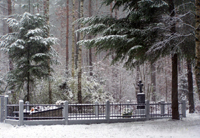 >
>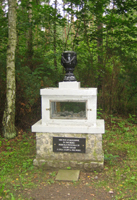
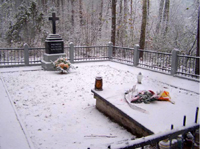
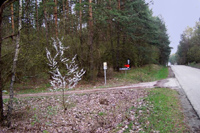

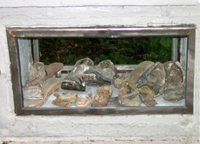
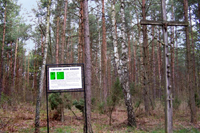

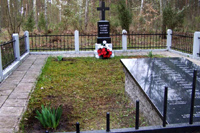
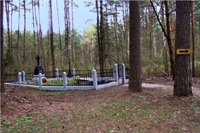
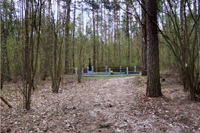

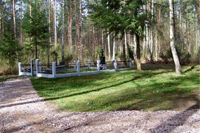
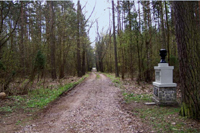
Translated by Łukasz Jałocha